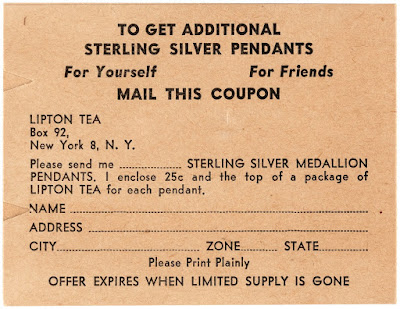 |
| Postcard |
From 1945 to 1946, the Thomas J. Lipton Tea Company sponsored Inner Sanctum Mystery, a creepy mystery radio program that aired during prime time over CBS. Prior to 1945, the program was sponsored by Carter's Little Liver Pills (starting in 1941) and in 1946 Emerson Drug took over the bankroll. During that one season under sponsorship with Lipton, the program underwent a number of changes. Raymond Edward Johnson, the program's original host, was replaced by Paul McGrath. Johnson became an overnight celebrity as a result of the program, receiving more fan mail than the program itself. When Johnson joined the Army, McGrath took over as the new host (without the name "Raymond"). In December 1945, Johnson delayed his decision to return to Inner Sanctum pending a choice for a Broadway show. This led to Johnson getting an agent and since director Himan Brown preferred to avoid agents so he could pay celebrities minimal (vs. paying an agent ten percent on top of the actor salary) so McGrath became the permanent host. Lipton added a female element named Mary Bennett to assist with the commercials. To this day, one of the two big mysteries of the radio program is whether Mary Bennett was a real person or a fictional name for the commercial spokesman.
 |
| An ink blotter given away to clients. |
The second appears to have been solved, which might be the biggest old-time radio mystery to be solved this year. During the commercial breaks, a silver sterling pendant was offered as a premium, described as "attractive" and with a Chinese inscription. Yet, over all these decades, no one was able to turn up a Chinese pendant giving most historians cause to suspect they were never mailed out. This summer a collector consigned a unique item to Hake's auction house which caught the attention of numerous old-time radio fans... the Chinese pendant.
Along with this elusive pendant in the same auction is a postcard for the consumer to submit 25 cents plus the box top of a Lipton package for additional pendants. The purpose of this pendant was to exceed an expectation set by the advertising agency, Young & Rubicam, to convince Lipton to renew their sponsorship. Lipton never did and the reason may have something to do with the pendant (possibly) never getting mailed out to radio listeners.
 |
| Yes, it does exist! |
Regardless of the reason behind the discontinuance of sponsorship, the pendant does exist. A major find in the history of old-time radio.


